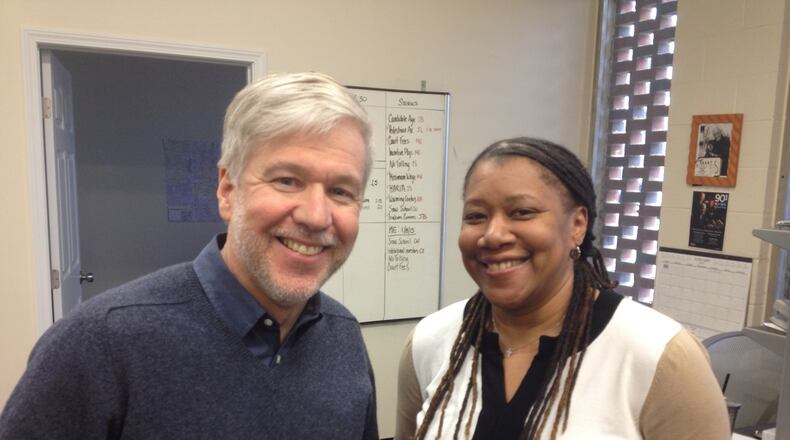By RODNEY HO/ rho@ajc.com, originally filed Thursday, May 7, 2015
Measuring the success of 90.1/WABE's fundraising drives has gotten more difficult for me because the station now relies so heavily on people who contribute monthly via automatic withdrawal from credit cards and bank accounts.
This spring's pledge drive raised $779,756. That is the worst total WABE has had in years and is down from $1.1 million in the spring of 2014. But the number is fundamentally misleading.
Not long ago, people had only one option: contribute a lump sum once a year. This made fundraising benchmarks easy to measure and trumpet.
But since the spring of 2013, WABE has built a database of more than 21,000 existing "sustainer" donors, up from 12,000 a year ago and 19,583 last fall. Sustainers now contribute more than $2.6 million a year separate from the bi-annual pledge drives. A little more than half of all donors are now sustainers. That money flows into Public Broadcasting Atlanta's coffers each month, evens out cash flow and is not counted in the pledge drive totals.
Studies show people tend to give more money when they are sustainers. So instead of donating a single $100 sum, someone might just give $10 a month, which feels less painful but in the end means WABE gets 20 percent more money from that individual per year.
The success of the sustainer program has enabled WABE to shorten its pledge drives, which used to run 12 days a decade ago but was trimmed to eight days last month, its briefest in years. The station no longer even pledges on weekends. So for listeners and employees alike, there is no downside.
Over the pledge drive, 2,083 people joined the sustainer donor list, adding on top of 19,000 existing ones. In the first couple of years, it was easier for WABE to grab low-hanging fruit in terms of finding sustainer donors. The number of new sustainers has dropped steadily each pledge drive, which is not unexpected, said chief operating officer John Weatherford.
According to the Greater Public’s 2014 Benchmarks for Public Radio Fundraising, seven out of 10 new donors who sign on as sustainers keep on giving the second year, double the percentage of one-time donors. At WABE, an incredible 95.1 percent of people who signed up as sustainers were still giving a year later.
Of the $779,756 pledged last month, 72 percent came from old-fashioned donors who contributed single lump sums like the old days.
Since the sustainer program began, WABE's overall individual donations have increased, indicating its efficacy. And Weatherford said response to their day-time switch to news/talk in January has been more positive than negative. He admitted the station lost classical music fans but that hasn't hurt fundraising to any tangible degree.
The downside to switching to news/talk is expense. WABE has expanded its news/editorial staff to about 20 from fewer than 10 a couple of years ago. The station is expecting to eat into reserves the next two years until donations will hopefully cover the increased costs.
Another upside to all the new news content flowing onto its website: traffic is up significantly, hitting one million page views for the first time in March. A year earlier, the site was receiving just 200,000 to 300,000 page views a month, Weatherford said.
Weatherford hasn't seen any obvious effect in terms of support since the arrival last year of Georgia Public Broadcasting programming on 88.5/WRAS-FM. Ratings for WABE have been fairly stable the past year, with about 400,000 listeners a week. (This does not include online on-demand listening or live streaming.) The station ranked 14th last month in overall Nielsen Audio ratings with a 3.2 share.
Although FY 2015 isn't over until June 30, Weatherford said individual donations for both WABE and its TV station have been consistently above target every month except last August. Individual contributions rose 7.8 percent between FY 2013 and FY 2014 to $6,552,865.
But corporate and foundation underwriting, he said, has been more of a roller coaster ride and might be down in FY 2015 vs. FY 2014. (Underwriting was up about 10 percent FY 2014 vs. FY 2013 to $4.44 million.)
I went over the organization's most recent form 990, a required financial statement non-profit groups must file with the government. It covers their year ending June 30, 2014. I also studied their audited financial statements covering the same period of time.
The numbers below include both the TV and radio stations.
The impact of the sustainer program is clearly evident, with revenues up 8.9 percent to $14,122,958, a record high from FY 2013's $12,973,670. (This includes in-kind contributions, which are included in PBA's audited statements, but not their tax form.) Expenses increased a modest 2.1 percent, to $13,855,761 from $13,569,083.
The number of full-time equivalent employees edged up to 88 year over year as of June 30, 2014 from 87 a year earlier. The total count is now in the 90s, Weatherford said.
The top 3 employees in terms of total compensation were the same as FY 2013, according to the 990 form:
2) John Weatherford, Chief Operating Officer, $235,154 (down less than 1%)
3) Jared Blass, Director of Underwriting: $188,186 (up 2.3%)
Nine employees receive $100,000 or more in compensation, including late morning host Lois Reitzes at $111,044. She is the best paid on-air personality but she has been at the station since 1979.
Charity Navigator, which judges various charities based on financial transparency and efficiency, gave Public Broadcasting Atlanta a rating of 80.54 out of 100, or three out of four stars. The site currently uses the previous year's Form 990 to calculate its ranking. The site gave PBA a higher rating for "accountability and transparency" (four out of four stars) than "financial" efficiency (two out of four stars).
Fundraising expenses ($3,415,740) represented 26.8 percent of total expenses, up 3.2 percent from $3,309,867 in FY2013, representing 26.3 percent of total expenses that year.
Program expenses ($7,319,597) were flat, representing 57.6 percent of total expenses.
Administrative expenses ($1,999,439) were up 4.4 percent and representing 15.7 percent of total expenses.
Government grants - meaning taxpayer monies - ($1,507,903) represented 11 percent of revenues, the same as a year ago.
Net assets bounced back from $8.9 million back to $9.4 million, the same as FY 2012. With additional expenses, net assets will probably fall off for FY 2015. The organization's financial position is significantly stronger than it was 15 years ago, when net assets were a mere $1.26 million.
About the Author
Keep Reading
The Latest
Featured




